Cascade Reservoirs: An Exploration of Spatial Runoff Storage Sites for Water Harvesting and Mitigation of Climate Change Impacts, Using an Integrated Approach of GIS and Hydrological Modeling
Abstract
:1. Introduction
2. Materials and Methods
2.1. Study Area
2.2. Data Collection and Preparation
2.3. Accuracy Assessment, Validation, and Sensitivity Analysis
3. Results
4. Discussion
5. Conclusions
Author Contributions
Funding
Data Availability Statement
Acknowledgments
Conflicts of Interest
References
- Rashid, M.U.; Abid, I.; Latif, A. Optimization of hydropower and related benefits through Cascade Reservoirs for sustainable economic growth. Renew. Energy 2021, 185, 241–254. [Google Scholar] [CrossRef]
- Solangi, G.S.; Siyal, A.A.; Siyal, Z.-U.; Siyal, P.; Panhwar, S.; Keerio, H.A.; Bhatti, N.B. Social and ecological climate change vulnerability assessment in the Indus delta, Pakistan. Water Pract. Technol. 2022, 17, 1666–1678. [Google Scholar] [CrossRef]
- Soomro, A.G.; Babar, M.M.; Arshad, M.; Memon, A.; Naeem, B.; Ashraf, A. Spatiotemporal variability in spate irrigation systems in Khirthar National Range, Sindh, Pakistan (case study). Acta Geophys. 2019, 68, 219–228. [Google Scholar] [CrossRef]
- Memon, A.; Ansari, K.; Soomro, A.G.; Jamali, M.A.; Naeem, B.; Ashraf, A. Estimation of groundwater potential using GIS modeling in Kohistan region Jamshoro district, Southern Indus basin, Sindh, Pakistan (a case study). Acta Geophys. 2019, 68, 155–165. [Google Scholar] [CrossRef]
- Yu, Y.; Zhao, R.; Zhang, J.; Yang, D.; Zhou, T. Multi-objective game theory optimization for balancing economic, social and ecological benefits in the Three Gorges Reservoir operation. Environ. Res. Lett. 2021, 16, 085007. [Google Scholar] [CrossRef]
- Sivakumar, M.V.K.; Vittal, K.P.R.; Eslamian, S. Indian Experiences in Water Harvesting Systems. In Handbook of Water Harvesting and Conservation: Case Studies and Application Examples; Saeid, E., Faezeh, E., Eds.; John Wiley & Sons, Ltd.: Hoboken, NJ, USA, 2021; pp. 325–339. [Google Scholar]
- Solangi, G.S.; Shah, S.A.; Alharbi, R.S.; Panhwar, S.; Keerio, H.A.; Kim, T.-W.; Memon, J.A.; Bughio, A.D. Investigation of Irrigation Water Requirements for Major Crops Using CROPWAT Model Based on Climate Data. Water 2022, 14, 2578. [Google Scholar] [CrossRef]
- Jehanzaib, M.; Shah, S.A.; Yoo, J.; Kim, T.-W. Investigating the impacts of climate change and human activities on hydrological drought using non-stationary approaches. J. Hydrol. 2020, 588, 125052. [Google Scholar] [CrossRef]
- Shah, S.A.; Jehanzaib, M.; Lee, J.-H.; Kim, T.-W. Exploring the Factors Affecting Streamflow Conditions in the Han River Basin from a Regional Perspective. KSCE J. Civ. Eng. 2021, 25, 4931–4941. [Google Scholar] [CrossRef]
- Li, D.; Lu, X.X.; Yang, X.; Chen, L.; Lin, L. Sediment load responses to climate variation and cascade reservoirs in the Yangtze River: A case study of the Jinsha River. Geomorphology 2018, 322, 41–52. [Google Scholar] [CrossRef]
- He, S.; Guo, S.; Yang, G.; Chen, K.; Liu, D.; Zhou, Y. Optimizing Operation Rules of Cascade Reservoirs for Adapting Climate Change. Water Resour. Manag. 2019, 34, 101–120. [Google Scholar] [CrossRef]
- Shah, S.A.; Jehanzaib, M.; Yoo, J.; Hong, S.; Kim, T.-W. Investigation of the Effects of Climate Variability, Anthropogenic Activities, and Climate Change on Streamflow Using Multi-Model Ensembles. Water 2022, 14, 512. [Google Scholar] [CrossRef]
- Abera, F.F.; Shumete, A. Optimal Operation of Cascade Reservoir Systems under Climate Change: Case Study of Tekeze Hydropower Reservoir in the Tributary of the Blue Nile River. Abyssinia J. Eng. Comput. 2021, 1, 31–46. [Google Scholar] [CrossRef]
- Foucher, A.; Evrard, O.; Cerdan, O.; Chabert, C.; Lefèvre, I.; Vandromme, R.; Salvador-Blanes, S. Deciphering human and climatic controls on soil erosion in intensively cultivated landscapes after 1950 (Loire Valley, France). Anthropocene 2021, 34, 100287. [Google Scholar] [CrossRef]
- Panhwar, M.Y.; Panhwar, S.; Keerio, H.A.; Khokhar, N.H.; Shah, S.A.; Pathan, N. Water quality analysis of old and new Phuleli Canal for irrigation purpose in the vicinity of Hyderabad, Pakistan. Water Pract. Technol. 2022, 17, 529–536. [Google Scholar] [CrossRef]
- Mirjat, M.S.; Soomro, A.G.; Mirjat, K.H.; Mirjat, M.U.; Chandio, A.S. Potential of Hill-Torrent Spate Irrigation in the Kohistan Areas of Sindh “A Case Study”. Pak. J. Agric. Agric. Eng. Vet. Sci. 2011, 27, 100–114. [Google Scholar]
- Rijsberman, F.R. Water scarcity: Fact or fiction? Agric. Water Manag. 2006, 80, 5–22. [Google Scholar] [CrossRef] [Green Version]
- Memon, A.; Ansari, K.; Ashraf, A.; Soomro, A.G. Identifying the hill torrents and Groundwater Resources for a remote area of District Jamshoro using Remote Sensing and Geographical Information System. Sindh Univ. Res. J. (SURJ) Sci. Ser. 2019, 54, 303–308. [Google Scholar] [CrossRef]
- Cai, X.M.; Rosegrant, M.W. World water productivity: Current situation and future options. Compr. Assess. Water Manag. Agriculture. CABI Int. 2003, 53, 163–178. [Google Scholar] [CrossRef] [Green Version]
- Sullivan, C.A.; Meigh, J.; Giacomello, A.M. The Water Poverty Index: Development and application at the community scale. Nat. Resour. Forum 2003, 27, 189–199. [Google Scholar] [CrossRef]
- World Bank. Reengaging in Agricultural Water Management: Challenges and Options; The World Bank: Washington, DC, USA, 2006; p. 218. [Google Scholar]
- Heryani, N.; Kartiwa, B.; Hamdani, A.; Muhardiono, I.; Rahayu, B. Rainwater harvesting technology to in-crease cropping index under perennial crops. In Proceedings of the IOP Conference Series: Earth and Environmental Science, Bogor, Indonesia, 16–18 September 2020. [Google Scholar]
- Han, F.; Zheng, Y.; Tian, Y.; Li, X.; Zheng, C. Accounting for field-scale heterogeneity in the ecohydrological modeling of large arid river basins: Strategies and relevance. J. Hydrol. 2021, 595, 126045. [Google Scholar] [CrossRef]
- Liebe, J.; Andreini, M.; van de Giesen, N.; Steenhuis, T. The small reservoirs project: Research to improve water availability and economic development in rural semi-arid areas. In The Hydro Politics of Africa: A Contemporary Challenge; Kittisou, M., Ndulo, M., Nagel, M., Grieco, M., Eds.; Cambridge Scholars: Newcastle, UK, 2007; pp. 325–332. [Google Scholar]
- United Nations Development Programme, 2016 Annual Report. Available online: http://web.undp.org/evaluation/documents/annual-report/2017/UNDP_ARE_2016.pdf (accessed on 13 September 2022).
- Soomro, A.G.; Babar, M.M.; Ashraf, A.; Memon, A. The Relationship between Precipitation and Elevation of the Watershed in the Khirthar National Range. Mehran Univ. Res. J. Eng. Technol. 2019, 38, 1067–1076. [Google Scholar] [CrossRef]
- Sindh Government, Potential Areas for Small Dams/Weirs. Available online: https://irrigation.sindh.gov.pk/small-dam (accessed on 13 September 2022).
- Human Development Report. (HDI). 2010. Available online: https://hdr.undp.org/content/human-development-report-2010 (accessed on 13 September 2022).
- Liu, J.; Yuan, X.; Zeng, J.; Jiao, Y.; Li, Y.; Zhong, L.; Yao, L. Ensemble streamflow forecasting over a cascade reservoir catchment with integrated hydrometeorological modeling and machine learning. Hydrol. Earth Syst. Sci. 2022, 26, 265–278. [Google Scholar] [CrossRef]
- Martel, M.; Glenn, A.; Wilson, H.; Danielescu, S.; Kröbel, R.; Smith, W.; McConkey, B.; Guest, G.; Janzen, H. A parsimonious water budget model for Canadian agricultural conditions. J. Hydrol. Reg. Stud. 2021, 36, 100846. [Google Scholar] [CrossRef]
- Memon, A.; Ansari, K.; Ashraf, A.; Babar, M.M.; Soomro, A.G. Projected Rainfall Variability Based on PRECIS Regional Model. Mehran Univ. Res. J. Eng. Technol. 2019, 38, 513–524. [Google Scholar] [CrossRef] [Green Version]
- Ren, K.; Huang, Q.; Huang, S.; Ming, B.; Leng, G. Identifying complex networks and operating scenarios for cascade water reservoirs for mitigating drought and flood impacts. J. Hydrol. 2021, 594, 125946. [Google Scholar] [CrossRef]
- Qiu, H.; Chen, L.; Zhou, J.; He, Z.; Zhang, H. Risk analysis of water supply-hydropower generation-environment nexus in the cascade reservoir operation. J. Clean. Prod. 2021, 283, 124239. [Google Scholar] [CrossRef]
- Yuan, F.; Sawaya, K.E.; Loeffelholz, B.; Bauer, M.E. Land cover classification and change analysis of the Twin Cities (Minnesota) Metropolitan Area by multi-temporal Landsat remote sensing. Rem. Sen. Environ. 2005, 98, 317–328. [Google Scholar] [CrossRef]
- Selçuk, R.E.I.S.; Nisanci, R.; Uzun, B.; Yalcin, A.; Inan, H.; Yomralioglu, T. Monitoring land-use changes by GIS and remote sensing techniques: A case study of Trabzon. In Proceedings of the 2nd FIG Regional Conference, Marrakech, Morocco, 2–5 December 2003; pp. 1–11. [Google Scholar]
- Brondizio, E.S.; Moran, E.F.; Mausel, P.; Wu, Y. Land use change in the Amazon estuary: Patterns of caboclo settlement and landscape management. Hum. Ecol. 1994, 22, 249–278. [Google Scholar] [CrossRef]
- Kachhwala, T.S. Temporal monitoring of forest land for change detection and forest cover mapping through satellite remote sensing. In Proceedings of the 6th Asian Conference on Remote Sensing, Hyderabad, India, 21–26 November 1985; pp. 77–83. [Google Scholar]
- Soomro, A.G.; Babar, M.M.; Memon, A.H.; Zaidi, A.Z.; Ashraf, A.; Lund, J. Sensitivity of Direct Runoff to Curve Number Using the SCS-CN Method. Civ. Eng. J. 2019, 5, 2738–2746. [Google Scholar] [CrossRef]
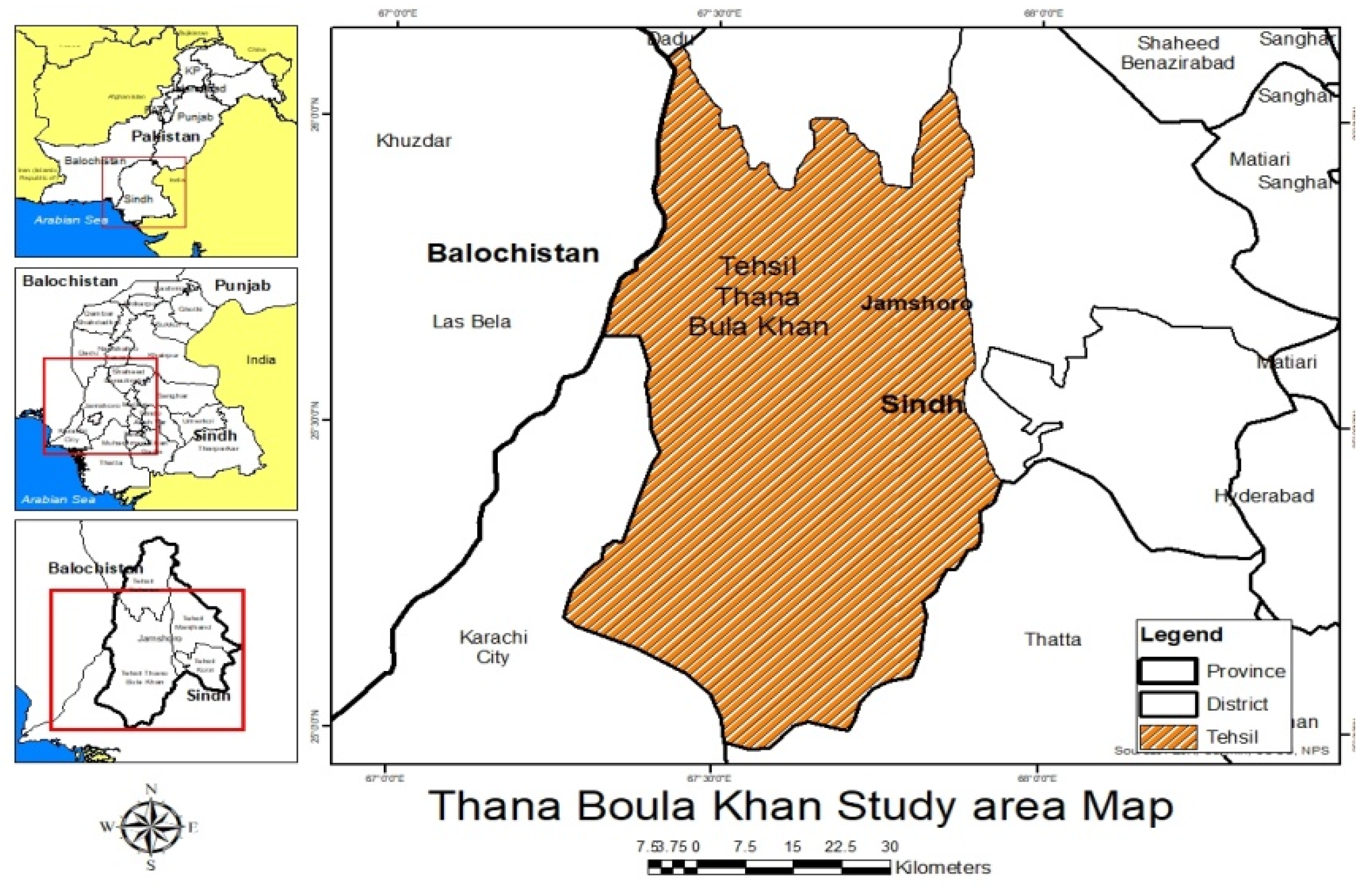
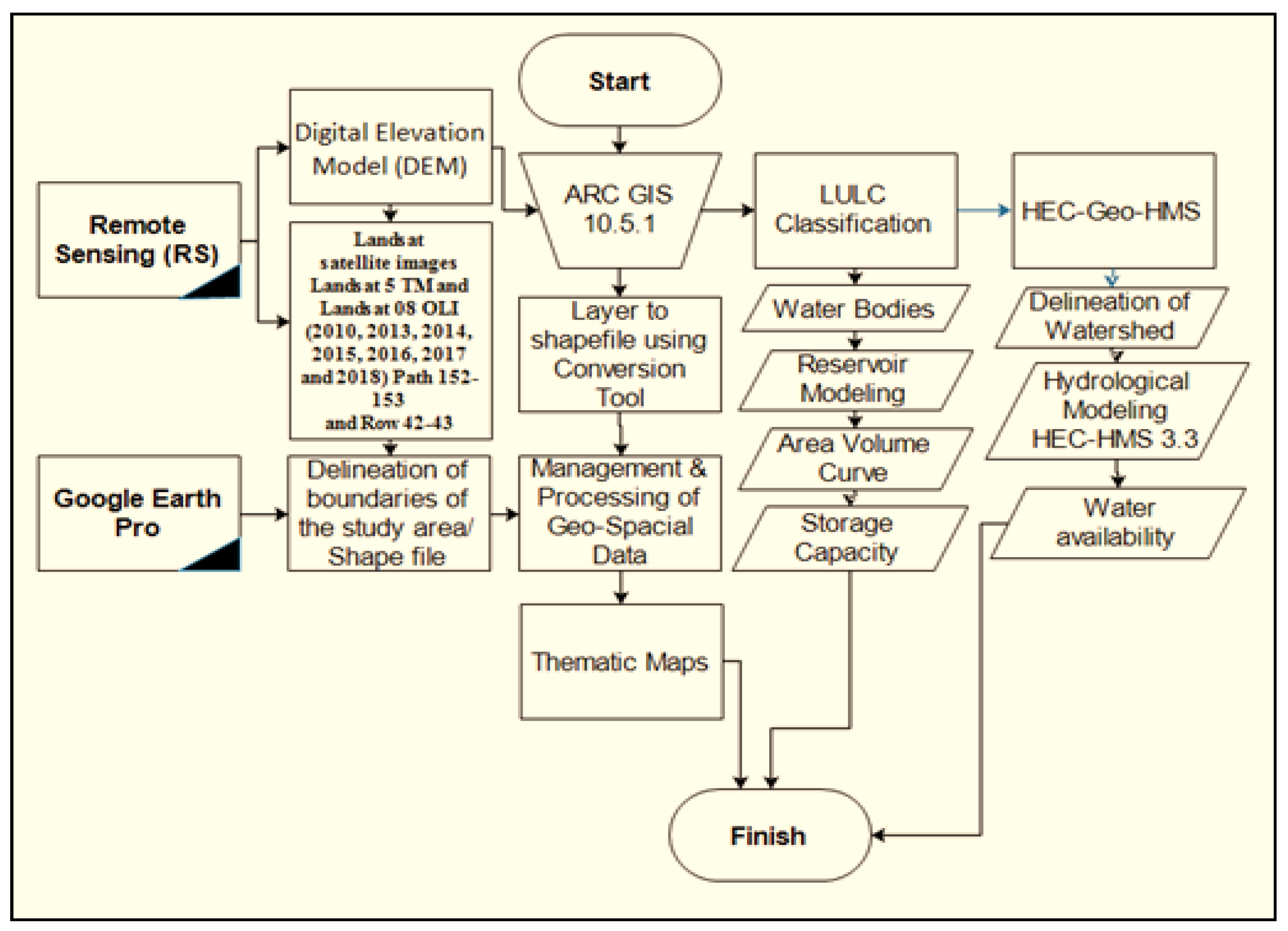
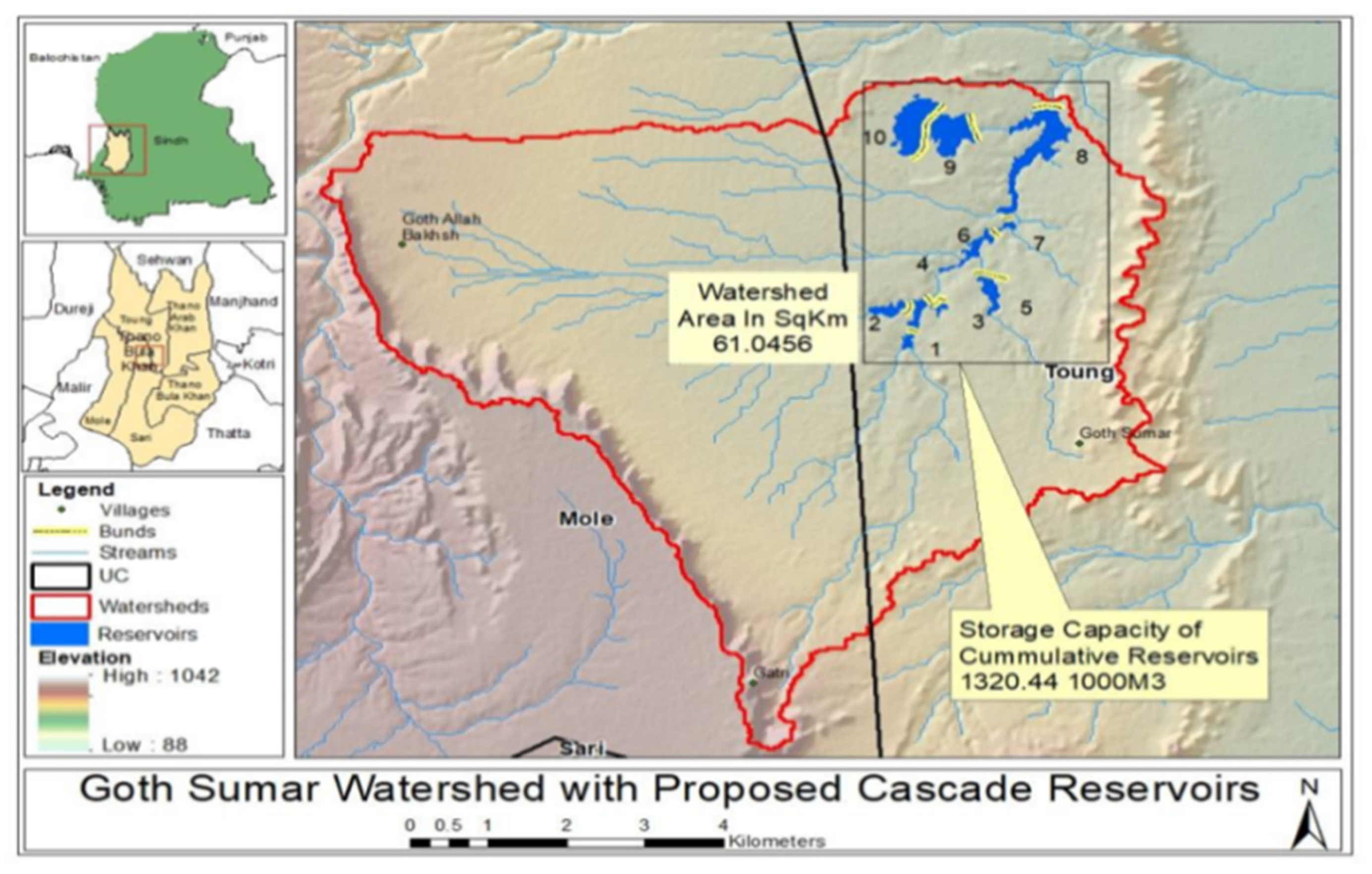
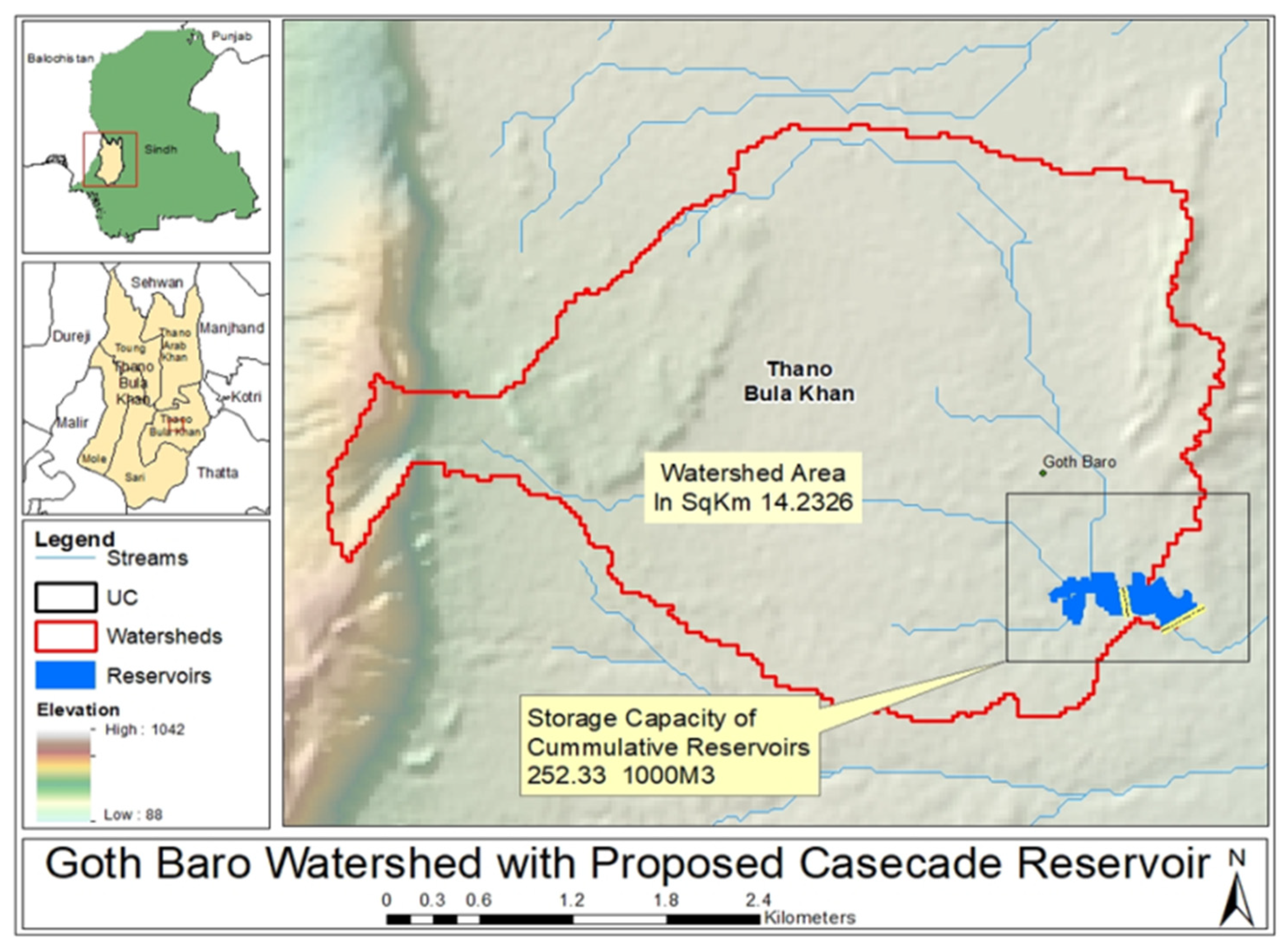

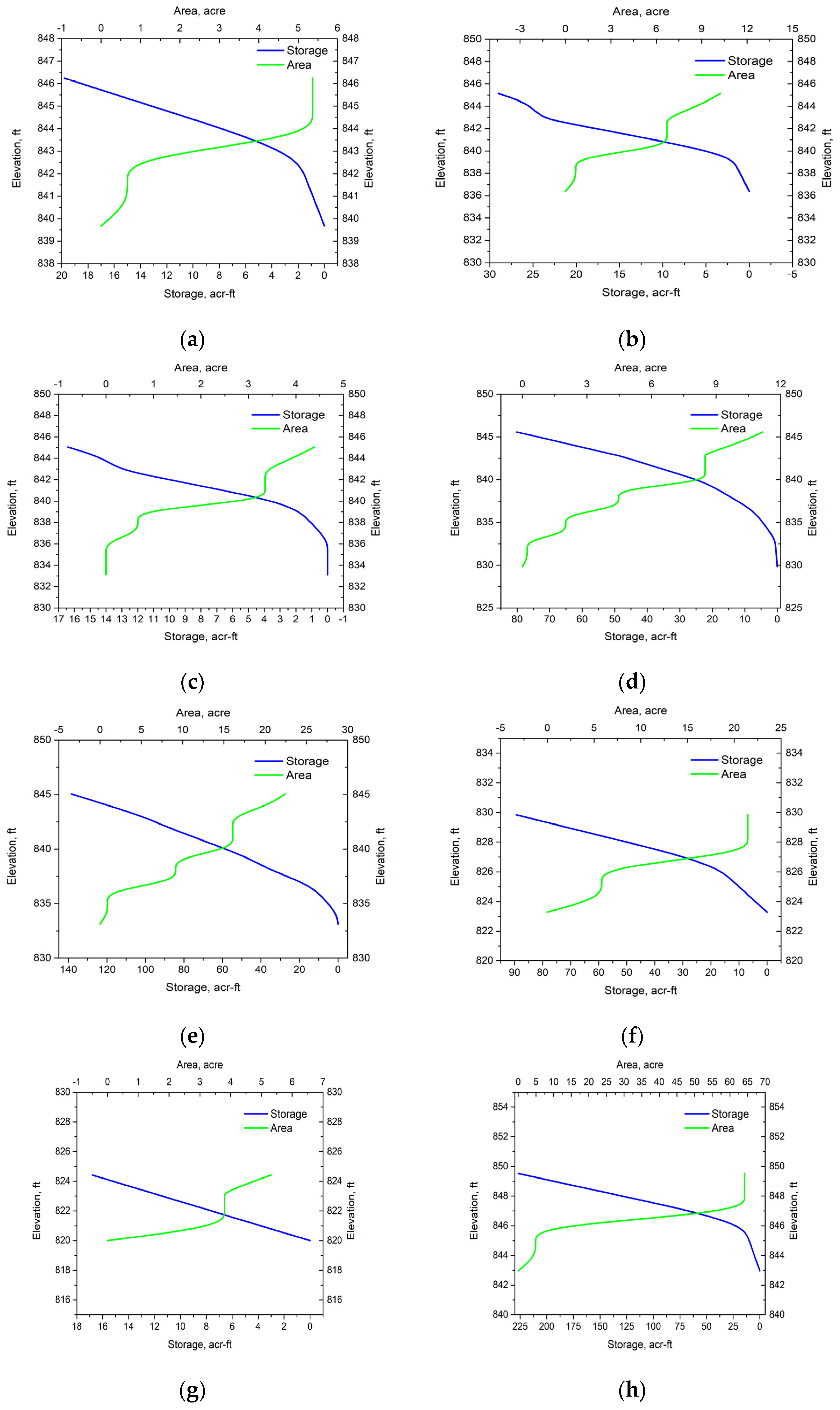
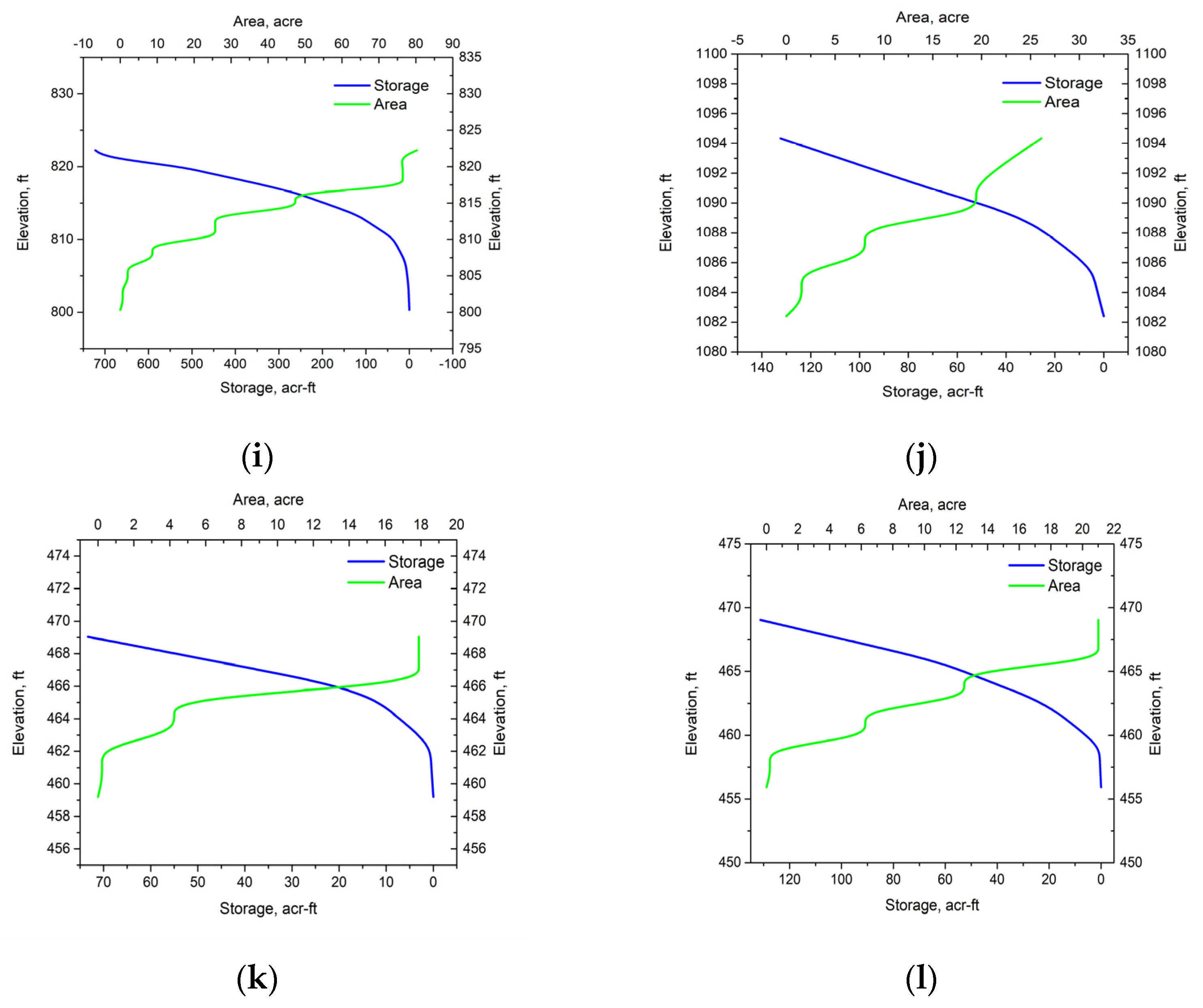
| Satellite/Spacecraft ID | Sensor ID | Path/Row | Year | Month | Spatial Resolution/Grid Cell Size (m) |
|---|---|---|---|---|---|
| Landsat 5 | TM | 152-153/42-43 | 2010 | September | 30 |
| Landsat 8 | OLI-TIRS | 152-153/42-43 | 2013 | September | 30 |
| 2014 | September | 30 | |||
| 2015 | September | 30 | |||
| 2016 | September | 30 | |||
| 2017 | September | 30 | |||
| 2018 | September | 30 |
| Return Period | Goth Sumar (MCM) | Goth Baro (MCM) |
|---|---|---|
| 5 | 12.35 | 2.88 |
| 10 | 16.47 | 3.84 |
| 20 | 21.43 | 5.00 |
| 25 | 21.72 | 5.06 |
| 50 | 25.21 | 5.88 |
| 75 | 40.53 | 9.45 |
| Storage Capacity | 1.32 | 0.25 |
Publisher’s Note: MDPI stays neutral with regard to jurisdictional claims in published maps and institutional affiliations. |
© 2022 by the authors. Licensee MDPI, Basel, Switzerland. This article is an open access article distributed under the terms and conditions of the Creative Commons Attribution (CC BY) license (https://creativecommons.org/licenses/by/4.0/).
Share and Cite
Soomro, A.G.; Shah, S.A.; Memon, A.H.; Alharabi, R.S.; Memon, D.; Panhwar, S.; Keerio, H.A. Cascade Reservoirs: An Exploration of Spatial Runoff Storage Sites for Water Harvesting and Mitigation of Climate Change Impacts, Using an Integrated Approach of GIS and Hydrological Modeling. Sustainability 2022, 14, 13538. https://doi.org/10.3390/su142013538
Soomro AG, Shah SA, Memon AH, Alharabi RS, Memon D, Panhwar S, Keerio HA. Cascade Reservoirs: An Exploration of Spatial Runoff Storage Sites for Water Harvesting and Mitigation of Climate Change Impacts, Using an Integrated Approach of GIS and Hydrological Modeling. Sustainability. 2022; 14(20):13538. https://doi.org/10.3390/su142013538
Chicago/Turabian StyleSoomro, Abdul Ghani, Sabab Ali Shah, Anila Hameem Memon, Raied Saad Alharabi, Darya Memon, Sallahuddin Panhwar, and Hareef Ahmed Keerio. 2022. "Cascade Reservoirs: An Exploration of Spatial Runoff Storage Sites for Water Harvesting and Mitigation of Climate Change Impacts, Using an Integrated Approach of GIS and Hydrological Modeling" Sustainability 14, no. 20: 13538. https://doi.org/10.3390/su142013538








